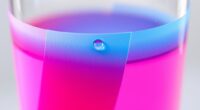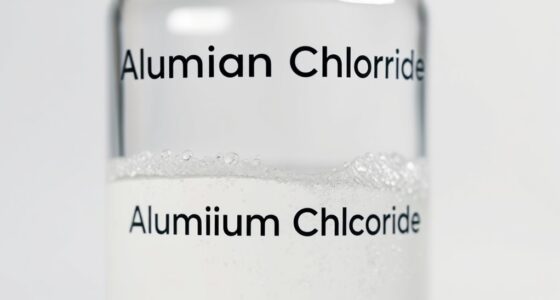The sky appears blue because Earth’s atmosphere scatters sunlight, and this scattering favors shorter blue wavelengths via a process called Rayleigh scattering. Molecules like nitrogen and oxygen in the atmosphere scatter blue light more efficiently than red, filling the sky with its hue. Variations in particles, weather, and altitude can change how the sky looks. To understand more about how atmospheric chemistry influences these effects, keep exploring this fascinating topic.
Key Takeaways
- Rayleigh scattering causes molecules like nitrogen and oxygen to scatter shorter blue wavelengths more efficiently than red.
- Blue light disperses in all directions in the atmosphere’s dense lower layers, filling the sky with blue hue.
- Atmospheric particles, aerosols, and pollutants influence sky color by scattering, absorbing, or filtering sunlight differently.
- Variations in atmospheric composition, altitude, weather, and seasons alter the intensity and shade of the blue sky.
- Scientific research and technological advances have clarified how atmospheric molecules and particles determine sky color.
Composition of Earth’s Atmosphere

The Earth’s atmosphere is primarily composed of gases that play crucial roles in supporting life and shaping our environment. You’ll find nitrogen makes up about 78.08% of the atmosphere, serving as a stable background gas. Oxygen follows as the second most abundant, accounting for roughly 20.95%, which is essential for respiration and combustion. Argon, a noble gas, makes up about 0.93%, while carbon dioxide, a key greenhouse gas, is around 0.04%. Water vapor, highly variable, averages about 1% at sea level and influences weather patterns. These gases exist within layered regions like the troposphere, where weather occurs, and the stratosphere, which contains the ozone layer. Trace gases like methane, nitrous oxide, and ozone contribute to climate regulation and protection from UV radiation. Additionally, the composition of gases can vary with altitude and local conditions, impacting phenomena such as cloud formation and atmospheric transparency. The interactions among these gases also influence atmospheric chemistry, shaping the overall climate and weather systems we experience.
The Science Behind Light Scattering

Have you ever wondered why the sky appears blue during the day? It’s due to a process called Rayleigh scattering, which occurs when tiny molecules in the atmosphere, like nitrogen and oxygen, scatter sunlight. Since shorter wavelengths, like blue, are scattered much more than longer wavelengths, such as red, the sky looks blue to us. The scattering intensity is inversely proportional to the fourth power of the wavelength, meaning blue light scatters about six times more than red. This scattering disperses sunlight in all directions, filling the sky with blue. During sunrise and sunset, sunlight passes through more atmosphere, scattering away more blue light and leaving the red hues. Rayleigh scattering explains the sky’s color and helps us understand atmospheric optics better. Additionally, advancements in AI-generated visualizations are increasingly used to simulate atmospheric phenomena, aiding in educational and scientific research.
Why Blue Light Dominates the Sky

Ever wonder why blue light dominates the sky during the day? It’s because atmospheric molecules, mainly nitrogen and oxygen, scatter blue light more efficiently than other colors. This happens through Rayleigh scattering, which increases scattering intensity as wavelength decreases—blue light around 474–476 nm gets scattered most. The small size of air molecules relative to blue wavelengths makes this process especially effective. Tiny air molecules are much smaller than blue wavelengths, so they scatter blue in all directions, filling the sky. Since blue light scatters more than red or green, the sky appears predominantly blue during daylight. Additionally, the scattering efficiency depends on the wavelength, further favoring shorter wavelengths like blue. Your eyes are also most sensitive to blue light in bright conditions, making the sky seem even more vivid. While some absorption occurs near sunset, during the day, blue’s efficient scattering ensures it remains the dominant color in the sky’s appearance.
Influence of Atmospheric Layers and Conditions

Atmospheric layers play a significant role in shaping the sky’s color by influencing how light scatters at different altitudes. In the troposphere, where air density and particle concentration are highest, most scattering occurs, making the sky appear blue. Automation technologies are also being integrated into weather monitoring systems to better understand atmospheric changes. Higher layers, like the stratosphere and mesosphere, contain fewer molecules and particles, so they contribute less to visible color but can produce phenomena like auroras. Variations in the composition of nitrogen, oxygen, and particles affect the wavelength and intensity of scattered light. At higher altitudes, the sky appears deeper blue due to less scattering interference, while closer to the surface, more aerosols and water vapor cause the sky to look paler or grayer. These atmospheric conditions directly influence how we perceive the sky’s color throughout the day.
How Aerosols and Particles Alter Sky Color

Aerosols and particles considerably influence the color and brightness of the sky by altering how sunlight is scattered across the atmosphere. When aerosols increase, especially near the sun, the sky becomes brighter and more pastel or earth-toned, as higher turbidity scatters light differently. Larger particles cause more forward scattering, focusing sunlight near the sun’s position, while smaller aerosols scatter light more evenly, affecting the diffuse brightness. Organic techniques for seed production can help reduce the number of harmful aerosols in the atmosphere around farming areas. Aerosols tend to scatter light at smaller angles, making the horizon opposite the sun appear dimmer compared to a clear atmosphere. Volcanic aerosols can even turn twilight skies crimson, far above the horizon. Their chemical makeup also impacts sky color: reflective aerosols brighten and cool the sky, while absorptive ones darken and warm it.
Sunset and the Red Appearance of the Sun

Have you ever wondered why the sun appears red during sunset? It’s because, at sunset, sunlight travels through a much longer path in the atmosphere compared to midday. This extended journey causes more scattering of shorter wavelengths like blue and violet, which are removed from the direct light reaching your eyes.
As a result, the longer wavelengths—red and orange—become more prominent. Rayleigh scattering impacts shorter wavelengths more strongly, so blue light scatters about ten times more than red.
Additionally, the low angle of the sun means sunlight passes through even more atmosphere, intensifying the filtering effect. This process, combined with atmospheric particles like dust or pollution, makes sunsets appear rich in reds and oranges, creating that beautiful, warm glow you see at day’s end. The presence of atmospheric particles can further enhance the scattering effect, intensifying the sunset’s vibrant hues.
Role of Ozone and Other Gases in Sky Color

Ozone plays a subtle but important role in shaping the sky’s color, especially when you view it from different angles or at varying solar positions. Its influence becomes more noticeable at larger viewing and solar zenith angles, as ozone absorbs specific wavelengths and alters the sky’s hue.
When the Sun is near the horizon, stratospheric aerosols reduce ozone’s contribution near the zenith. At higher altitudes, like 10 km, ozone’s effect increases. The total ozone column influences how much the gas impacts sky color.
While ozone has a noticeable role, other gases like nitrogen and oxygen primarily drive Rayleigh scattering, which gives the sky its blue appearance. Pollutants, dust, and water vapor can modify this effect, but ozone’s contribution remains subtle and dependent on atmospheric conditions.
Historical Discoveries on Sky Color

Throughout history, humans have sought to understand why the sky appears blue, often relying on observation and cultural explanations before scientific methods emerged. Al-Kindi, around 850 AD, suggested that dust and haze particles interacting with sunlight caused the blue hue. Ancient cultures believed atmospheric particles blended with sunlight to produce color, with no precise understanding. Leonardo da Vinci linked the sky’s color to atmospheric conditions, noting effects in landscape painting and aerial perspective. In the 19th century, John Tyndall demonstrated that tiny particles scatter shorter (blue) wavelengths more than longer ones, explaining the sky’s color scientifically. His experiments, known as the “Tyndall effect,” clarified how scattering causes the blue daytime sky and reddish sunsets. These discoveries marked key steps from myth to science in understanding sky color. The development of understanding light scattering has been crucial in explaining why the sky appears blue during the day.
The Impact of Weather and Seasons on the Atmosphere

Ever wondered how different seasons and weather conditions change the way the sky looks? Seasonal shifts alter the levels of particles and gases that interact with sunlight, affecting sky colors.
In summer, increased humidity boosts the scattering of shorter wavelengths, making the sky appear more vibrant blue. During winter, drier air often results in a deeper blue, with less water vapor to scatter light.
Pollen and dust levels fluctuate seasonally, changing how particles scatter or absorb sunlight.
Weather patterns also play a role: clear, high-pressure days produce bright blue skies, while overcast, rainy, or foggy conditions scatter light diffusely, dulling the blue.
Wind can carry pollutants, impacting aerosol levels and light scattering, and temperature inversions can trap pollutants near the surface, further dulling sky color.
Additionally, ultra-fine particles from pollution or natural sources can influence the intensity and hue of the sky by scattering or absorbing sunlight in different ways.
Ongoing Research in Atmospheric Chemistry

Advances in atmospheric chemistry research are shedding light on how various chemical processes influence the composition and behavior of the atmosphere. You’ll find scientists studying Volatile Organic Compounds (VOCs) to better understand their role in forming ozone and aerosols, which impact air quality and climate.
Researchers are also exploring mercury’s transformation pathways, aiming to improve predictions of mercury deposition and its environmental effects. Model development is a key focus, with efforts to refine chemical mechanisms and reduce discrepancies between predictions and observations.
Field measurements validate these models, while new satellite data enhances remote sensing capabilities. Technological innovations like chemical ionization mass spectrometry and advanced sensors are pushing the boundaries of detection.
Frequently Asked Questions
How Does the Earth’s Rotation Influence Sky Color Variation?
Your Earth’s rotation influences sky color variations by changing the sun’s position relative to you. As the planet turns, the sun appears higher or lower, altering the angle sunlight enters the atmosphere.
This affects how much blue light is scattered during midday, making the sky appear blue, and how longer paths during sunrise or sunset filter out blue, revealing reds and oranges.
Your position and Earth’s rotation create these dynamic sky color shifts throughout the day.
What Role Do Pollutants Play in Changing Sky Hues?
Pollutants considerably alter sky hues by increasing aerosol particles like dust, soot, and water droplets in the atmosphere. These particles scatter light differently, making the sky look faded, greyish, or tinted with green, yellow, or orange.
During sunrise or sunset, pollution enhances warm colors like red and orange. You’ll notice these changes as indicators of air quality, with more pollution leading to hazier, less vivid blue skies.
Why Does the Sky Sometimes Appear Purple or Pink Instead of Blue?
Imagine the sky as a painter’s canvas, sometimes splashed with purple or pink instead of blue. You see, when atmospheric particles or charged particles from the magnetosphere interact with gases, they create these vibrant hues.
These interactions energize the air, much like adding new colors to a painting, resulting in pinks, purples, or reds.
Weather, pollution, and solar activity all influence which colors you see, transforming the sky into a dynamic masterpiece.
How Does Altitude Affect the Color and Clarity of the Sky?
You’ll notice that at higher altitudes, the sky’s color shifts because the atmosphere becomes thinner, reducing Rayleigh scattering. This means less blue light gets scattered, so the sky may appear darker or even black above about 50 km.
Additionally, higher elevations offer clearer skies with less pollution, improving visibility of celestial objects.
Can Atmospheric Chemistry Explain the Colors of Sunsets and Sunrises?
Atmospheric chemistry shapes the stunning colors of sunsets and sunrises. You see, during these times, sunlight takes a longer path through the atmosphere, scattering short wavelengths like blue and violet away.
What remains are warm hues—reds, oranges, and yellows—that dominate the sky. Pollutants and aerosols can mute these colors, while cleaner air makes them more vivid.
Conclusion
Understanding why the sky is blue reveals both the simplicity of natural light and the complexity of atmospheric chemistry. While the clear daytime sky dazzles with blue, the same atmosphere transforms at sunset into fiery reds and oranges, reminding you of nature’s artistry. This contrast highlights how invisible particles and gases shape your daily experience, turning the sky into a canvas of scientific wonder and poetic beauty—an ongoing dance between chemistry and perception.









